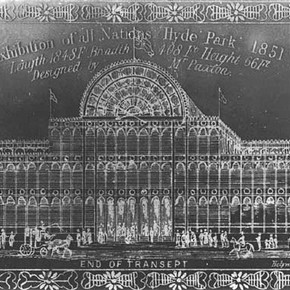Conservation Journal
October 1996 Issue 21
An Object Media Enigma
One of the most interesting aspects of working with albums, and by this I refer to any blank book with objects adhered to the leaves, is the diversity of material to be found within them. However, nothing was to prepare me for the extraordinary prints I came across in an album from the National Art Library collection - engravings printed in gold on coloured gelatine.
The prints belong to a collection of material relating to the Great Exhibition of 1851, including tickets, songsheets, cards, invitations, notepaper and other ephemera, given to the V&A in 1867 by Charles Wentworth Dilke, one of the six Executive Committee Members of the Great Exhibition.
There were originally seven prints, each measuring approximately 75mm x 115mm, but only six now remain - three blue, two red and one turquoise. When they came to Book Conservation they had all been adhered at the corners to the same page, causing extensive cockling to the paper leaf. The brittleness and inflexibility of the gelatine was hindering the flow of the page, resulting in the prints being vulnerable to further damage. It was therefore decided, in consultation between Book Conservation and two NAL curators, to remove them and mount them out of the album (they are to be housed together in the same conservation box). Further conservation requirements to re-attach and repair damaged, detached corners are still being investigated and will not be dealt with in this article.
The prints are most unusual objects and despite extensive enquiry I have been unable to find out any information on such media from either a curatorial or conservation aspect, and no one I have spoken to has seen or heard of prints of this nature. In researching the official guide of the Great Exhibition I unearthed four entries under France that mention related material:
-
BOUASSES, LEBEL & CO., Paris - producers. 'Samples of gelatine pictures'
-
CASTELLE, H., Paris - Manufacturer. '...printed gelatine. Engraved and knotched gelatine. Gelatine for printing, boardings, drawings, engravings, flowers and decorations for theatres etc. (new invention)'
-
LECLERCQ, No., Paris - manufacturer. 'Specimens of gelatine in white and coloured leaves'
- ROYER, JOSEPH CHARLES, La Tournelle - Manufacturer. 'Specimens of gelatine leaves of all colours'
But even taking this into account, it does not fully explain their provenance: the engravings are English, published by J.T. Wood of Holywell Street, London. I have been unable to find any copies of these engravings on paper (admittedly this avenue has only been touched on) but I am certain they must be extant in material collected from the Great Exhibition. Is it possible, therefore, that these engravings were printed at the time as a form of souvenir, or even after the event, by a printer who had purchased the French coloured gelatine and wished to experiment with a new substrate? After all this exhibition was all about the works of industry; encompassing manufacture, design and technology.
I presume that they are essentially experimental and are in many respects a precursor to printing on acetate film, but this innovative form of production still remains a mystery. Perhaps someone reading this article can throw light on this conservation and historical dilemma?
October 1996 Issue 21
- Editorial
- Plastics? Not in My Collection
- Plastic, Pop and Mass-produced Design in the V&A's Collections
- Two Pooped-out Pop Chairs: What is the Future for our Plastic Collections?
- An Object Media Enigma
- Milk and Modernism: Conservation of a Smoker's Cabinet designed by Charles Rennie Mackintosh
- 'Sham Columns in a Casing of Crockery'
- Printer Friendly Version
